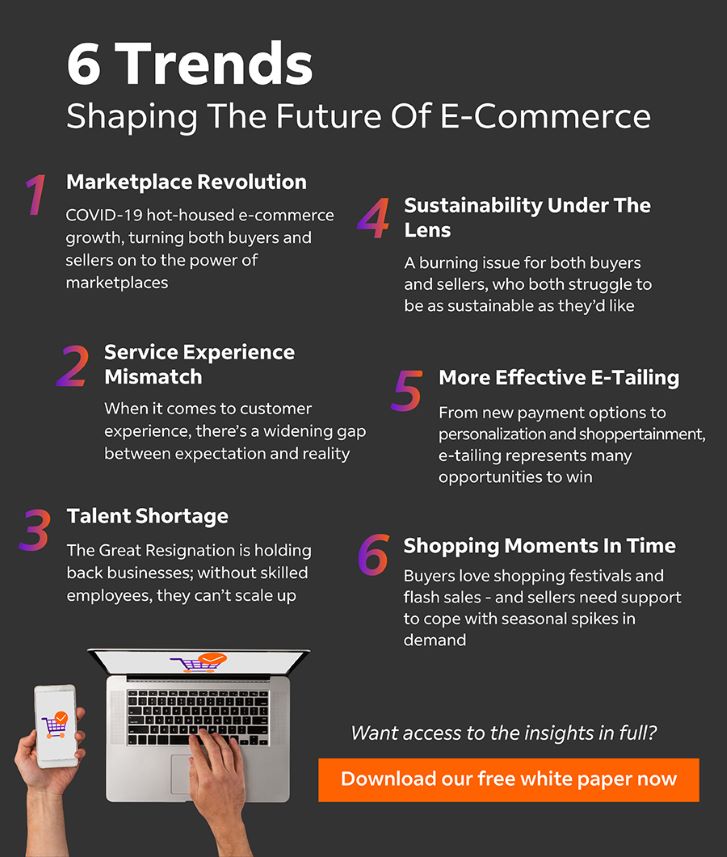
6 Trends Shaping The Future Of E-Commerce
By FedEx | First published: September 21, 2022 Updated: July 3, 2024
Our e-commerce white paper explores key e-commerce trends in some of the fastest-growing markets in Asia Pacific. We identify the driving forces e-tailers can leverage on to fuel business growth.
- Six key trends are shaping the future of e-commerce, from sustainability to the customer service gap.
- Smart e-tailers can tap the latest mega-trends in Asia Pacific and stay ahead of the competition.
- A breakdown of all 6 trends is available now in our free e-commerce white paper.
As businesses around the world navigate an unstable economy, retailers and consumers are looking ahead to what’s next. Despite economic upheaval, e-commerce trends continue to play out globally. And they have the power to shape what’s to come.
However, staying at the forefront of innovation and digital commerce trends will help e-merchants stay agile and resilient.
Which e-commerce developments are here to stay? How will digital technology innovations impact the future of retail? And what online shopping trends do both buyers and sellers see as critical for the months ahead?
We examine these questions in our e-commerce white paper. Click here to download the report now.
Leading the e-commerce charge in Asia Pacific
Asia Pacific contains markets of enormous diversity and varying levels of retail maturity. The region offers valuable insights into recent and future developments in e-commerce.
APAC is driving the retail industry forward, generating about three-quarters of global growth. One example is how the expanding middle class is spurring e-commerce growth across the region, with Asia's middle class predicted to increase from 2 to 3.5 billion by 2030. These consumers seek a highly personalized and convenient online shopping experience from purchase to delivery.
What our white paper reveals
Our e-commerce white paper* is based on the FedEx What’s Next in E-Commerce survey. We polled small and medium-sized enterprises (SMEs) and consumers in 11 markets in Asia Pacific.
Six key trends were identified in the report including:
The global ‘revolution’ in e-commerce shaping new customer experiences post COVID-19
‘Last-mile’ delivery vs heightened consumer demand for sustainable, eco-friendly solutions – and how SMEs are responding
The impact of the ‘Great Resignation’ on how businesses retain and recruit new talent across the region
E-tailers and consumers agree that there’s room for more growth in the already booming e-commerce sector. But there are challenges ahead. SMEs are busy navigating them already: evolving online sales platforms, adopting new payment methods and meeting delivery requirements to stay ahead of the competition.
At FedEx, we’re here to support businesses as they expand, tap new import and export markets and grow customers. As new digital commerce trends emerge, a clear roadmap for where the industry is headed can help businesses grow.
We’ll continue to help unlock new opportunities as the frontiers of e-commerce advance, enabling e-merchants to optimize customer experience.
Don’t miss these essential insights on the future of e-commerce. Download our free white paper now!
***
*To access the individual market report for each region, click on the name of the market here: Australia, Hong Kong, Japan, Malaysia, Philippines, Singapore, South Korea, Taiwan, Thailand and Vietnam.
SHARE THIS STORY
- Generative AI: A New Frontier
- How To Ship A Giant Panda
- How To Make Freight Shipments Work For Your Small Business
- The Rise Of Intra-Asia Trade: Opportunities In The China-Southeast Asia Corridor
- Where Do Old Planes Go When They Retire?
- What’s So Dangerous About Coconuts? Your Guide To Dangerous Goods Logistics
Sign up now and save on your shipping rates!
Sign up now and earn discounts by shipping instantly with FedEx Ship ManagerTM at fedex.com.
Recommended For You

7 Biggest E-Commerce Megatrends To Watch Right Now
Our newly-released white paper examines how China, the biggest e-commerce market in the world, is witnessing trends that will define what’s next.
Read More
Introducing The Latest Megatrends In E-Commerce
Digital megatrends are transforming logistics. We look ahead to map how these shifts in online and consumer behavior can benefit SMEs.
Read More
How E-Commerce Integration Has Transformed Online Retail
The rise of new, tech-driven e-commerce platforms has led to a new era of online retail. We’re now in the omnichannel age of e-commerce integration.
Read More

